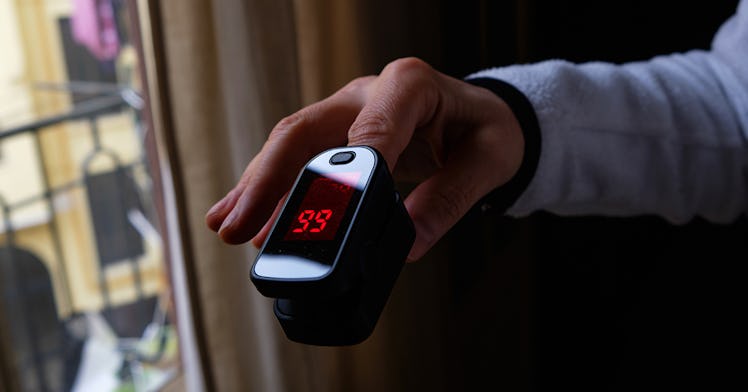Do You Need a Pulse Oximeter to Track Coronavirus Symptoms?
Sales of pulse oximeters, devices that measure blood oxygen levels, are through the roof. That doesn't mean it's time to get on the bandwagon.

Sales of pulse oximeters, simple devices that monitor blood oxygen levels, have skyrocketed over the past several weeks. Everyone from Bravo talk show host Andy Cohen to CNN journalist Chris Cuomo have suggested buying the devices to trace COVID-19 symptoms. Pulse oximeters painlessly clip onto the end of a finger and are typically used by people with heart and lung conditions. Now, people without any diagnoses are using the devices to try to determine whether they have COVID-19 — or if they have a confirmed case, whether they need to go to the hospital. But is there any scientific merit to having a pulse oximeter at home?
Not really. “Just like toilet paper, everybody wants it. That doesn’t mean they need it,” says Len Horovitz, an internist and pulmonary specialist in private practice in Manhattan, New York. If you don’t have respiratory symptoms such as a cough or difficulty breathing, a pulse oximeter — also known as a “pulse ox” — is of no use to you, Horovitz says. Without those symptoms or an underlying condition — or exercise or being in elevation — your oxygen levels will not suddenly drop.
“Monitoring your pulse ox when you don’t have any symptoms can lead you astray,” adds Rachel Bruce, associate chair of emergency medicine at Long Island Jewish Forest Hills in Queens, New York. Many of the devices aren’t accurate, aren’t approved by the FDA, and say on the label that they aren’t intended for medical use, Bruce says.
Other expert recommendations are more mixed when it comes to people with suspected or confirmed COVID-19 using pulse oximeters. Some hospitals are giving the devices to patients who would have been admitted under normal circumstances but turned away due to a lack of resources, according to Reuters. New York-Presbyterian Hospital has given the devices to more than 200 people to use at home, and a doctor or nurse practitioner reviews the patients’ numbers every 12 or 24 hours. As of April 8, about 15 percent had been admitted to the hospital after being sent home with the device.
But if a doctor hasn’t told you to buy a pulse oximeter and you don’t have a medical professional to go over your numbers with, don’t get one, Bruce says. It’s not necessary and can cause undue panic if you read or interpret your levels incorrectly. Besides, numbers aren’t everything. “The important thing is to focus on how you feel, not a number on a machine,” she says. If you get winded walking to the bathroom or finishing a sentence, consider a trip to the emergency room, even if your number is normal. If your number is low but you feel fine, check in with your doctor.
Another reason not to buy a pulse oximeter is that they’re in low supply. “It’s just like with the N95 masks,” Bruce says. “You have to keep them where they’re needed most.” Right now, that means people with heart and lung conditions and people with COVID-19 that have been directly advised to use one by a medical professional.
If you are going to buy one or already have one at home, make sure you aren’t wearing nail polish, which can disrupt the reading. Cold fingers can also throw off the numbers, so warm them up before you test. Use traditional devices that clip onto a finger and avoid smartphone apps, which are less effective, according to the California Thoracic Society.
Now is the time to go back to basics. Trust your body. If you’re having trouble breathing, call your doctor or the emergency room, because you don’t need technology to tell you when you don’t feel well.
This article was originally published on